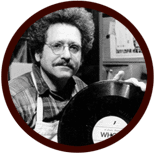 |
||
|
|
||||||||||||||||||||||||||||||||||||||
|
Restoring the DiscsBefore digital audiotapes, before cassettes, before even reel to reel, the standard recording medium was the acetate disc. Acetate--a soft, plastic-like coating onto which sound was engraved--was applied to discs made of aluminum, glass, or paper. The sound quality could be quite good, but the medium was never meant to last. Even under the best storage conditions, acetate discs are notorious for exuding a greasy white film, the most apparent sign of nitrocellulose acetate decomposition. Under less than optimal conditions, the acetate coating can shrink and crack like the surface of a desert floor. Sometimes, the acetate's hold on the aluminum disc becomes so fragile that the acetate coating lifts off as it is being played. Once Henry Sapoznik joined forces with producer Dave Isay and Sound Portraits Productions to begin work on the Yiddish Radio Project, Andy Lanset, one of New York's premier sound preservationists, was brought on to save the discs. In his lab, Lanset would start by examining each disc and choosing the cleaning method best suited to its condition. Some just needed to have the grit and schmutz flushed from their grooves; others had to be treated with special agents to replenish elements leached over time. After cleaning, the right stylus was selected for playback. A stylus that is too narrow can damage a disc, and one that's too wide won't get all the sound. During playback, three transfers were made: a reel-to-reel archival master, a compact disc, and a reference DAT used to produce the radio series. After transfer, each acetate disc was given a fresh acid-free sleeve and reshelved in a temperature- and humidity-controlled environment. (Many of the clips later used in the Yiddish Radio Project NPR series also received a subsequent digital cleanup from Gary Covino, the series' editor and technical wizard.) After each transfer was completed, the disc information was entered into a database modeled on the extended format used by the Library of Congress and the Smithsonian Institute. In 2004 the audio collection, together with reams of related papers and photographs, will be transferred to the Library of Congress. Next Page: Jews in Mainstream Media »
|
|||||||||||||||||||
| Copyright 2002 Sound Portraits Productions. All rights reserved. | |||

